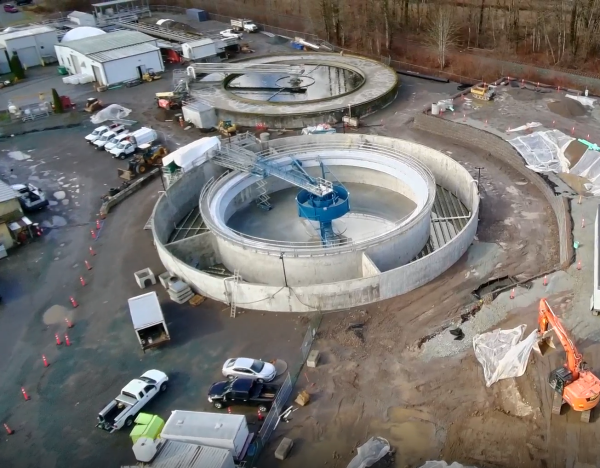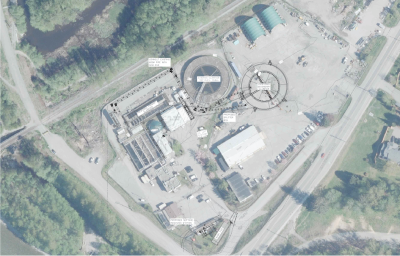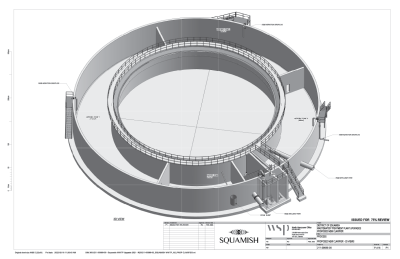Wastewater Treatment Plant Expansion and Improvements

A new secondary clarifier and concentric ring bioreactor is being built. This major upgrade will increase treatment capacity, provide system redundancy, increase seismic and flood resiliency, improve plant performance and effluent quality, decrease biosolids production and associated energy usage, and decrease carbon emissions and handling costs.
PROJECT TIMELINE:
Construction is anticipated to take place through summer 2025.
Updates
Current work done as of March 2025
Circular Clarifier/Bioreactor Tank
- Concrete works for the new tank are complete.
- Rotating clarifier mechanism has been successfully installed and tested.
- A network of wastewater piping, aeration piping and valves were installed throughout the site. All major ties ins are complete.
- Electrical kiosks, conduits and cable have been installed, along with control system upgrades. Final inspection and testing is underway.
- All ancillary items including pumps, aeration system, access stairs, safety railings, water service etc. have been installed.
- Commissioning of the new tank and Operator training is scheduled for April.
- The new treatment tank is expected to be fully operational in May.
- Site grading and restoration activities will proceed into the Summer.
- Circular Clarifier/Bioreactor Tank Progress Photos:
Septage Receiving Station (SRS)
- Construction of the new SRS has been progressing well.
- Foundation, framing, roofing, rough plumbing and electrical, siding, windows, and doors are all complete.
- Install of mechanical equipment, finish electrical and plumbing work is ongoing.
- Access ramp construction is scheduled for April.
- Commissioning of the new station and Operator training is scheduled for May.
- The SRS is expected to be fully operational and accepting septage from commercial haulers in June.
- Public Works staff are coordinating outreach to users.
- Site grading and restoration activities will proceed into the Summer.
- Septage Receiving Station progress photos
Conversion of a Secondary Clarifier Tank Into a Primary Clarifier
- This scope of work will begin once the new circular is fully operational.
- A primary clarifier, also known as a primary settling tank, removes suspended solids and remaining grit from wastewater. Heavier solids to settle at the bottom and lighter organic materials to float to the surface for removal.
- Primary clarification reduces the burden on subsequent treatment stages.
- This conversion optimizes existing infrastructure, providing value for its remaining useful life.
- Primary clarification will help reduce biosolids production and aeration energy costs.
- Project completion is expected in July.
Upgraded Wastewater Treatment Plant Benefits
- Designed to be ‘Post Disaster’ able withstand seismic and flood events.
- Provide additional treatment capacity to keep pace with projected population growth.
- Provide treatment redundancy in accordance with BC Municipal Wastewater Regulations.
- Improve the quality of the effluent released into the environment.
- Decrease biosolid production which improves energy usage, carbon emissions and handling costs.
Septage Receiving Station Benefits
- Improved access and security.
- Improved operability and hygiene for Operator and Haulers.
- Improved waste screening and debris removal.
- Automated volume monitoring and billing.
- Higher level of service to commercial haulers and the wider community.
- New heavy duty wash bay with run off containment via an oil grit separator.
Previous Updates
- Deconstruction of existing storage sheds was completed in May 2022 - 95% landfill diversion was achieved by salvaging useful materials, source separation, recycling of materials, and relocation of intact buildings off-site for continued use.
- Environmental and Archeological Permits obtained May 2022 - Due to the nature of the activities at the WWTP site, significant contamination drilling, testing, mapping and reporting were required before any excavation activities could commence. This was required to determine and delineate any potential contamination and provide recommended rehabilitation. Due to the location of the site and the higher archeological potential, numerous archeological test digs, reporting and consultation with First Nations assessed the site before any excavation activities commenced.
- Relocation of impacted utilities and mass excavation under the proposed new circular treatment tank was completed in September 2022 - All impacted utilities were decommissioned and/or rerouted around the circular excavation. This included the installation of 100m of 900mm storm main. All contaminated soil was removed and disposed of following strict environmental regulations and practices. To reduce offsite removal and trucking costs, excavated materials were repurposed for Public Works facility preload.
- Ground improvements were completed in October 2022 - Deep soil mixing was implemented to densify the ground under the proposed circular tank to prevent ground liquefaction during an earthquake and increase seismic resistance. This was required as this infrastructure is designed to be a post-disaster structure. Low-strength concrete panels were drilled to a depth of 13m. An onsite concrete batch plant was constructed to reduce concrete truck traffic and ensure consistency in product and delivery.
- Detailed Design and Tendering for the next phase completed in September 2022 - Eight contractor proposals were received and reviewed.
Next Steps: Contract award for the next phase of construction
We are currently interviewing contractors for the next phase of construction. Next phase of work includes; tank construction, piping, septage receiving station, rehabilitation and reuse of some existing tanks. The anticipated contract award is December 2022 with construction expected to start back up in early Jan 2023. Timeline for project completion is Q1 2024.
- Stormwater management established. Dewatering of excavation is on going. Erosion sediment control measures are in place.
- Environmental monitoring during construction ongoing.
- Underslab piping fabrication, excavation, pipe installation and pipe encasement completed.
- Centre column foundation excavation, rebar install and concrete poured.
- Mud slab poured
Current work done as of February 2024:
- Construction of the structure's walls will take place through June 2024
- Concrete base slab for the new circular treatment tank is complete
- Added concrete and rebar installation to base complete as part of the structure's post-disaster plan
- Base slab for the new septage receiving station is complete
Background
The Squamish Wastewater Treatment Plant is reaching full capacity and requires upgrades to meet population growth forecasts and redundancy requirements in accordance with the Municipal Wastewater Regulations. This refers to the need for 75% biological treatment capacity with the largest unit out of service. Currently the plant has 55% redundancy which would be reduced further based on projected future flows.
The existing treatment units are approaching end of life and and do not meet current seismic and flood protection design considerations. The new post-disaster infrastructure will be able to withstand seismic and flood events, which is of critical importance in light of recent catastrophic flooding events across British Columbia.
A $12.3M contract was awarded to Tritech Group Ltd in August 2023 for the construction of the new circular treatment unit and septage receiving station at the WWTP. Tritech is a General Contractor based out of the Lower Mainland that specializes in WWTP construction.
Appropriate building permits were secured in September 2023 and the contractor mobilized for site setup with temporary power and fencing installed.
Project Information
The scope of work includes:
- Construction of new secondary clarifier and concentric ring bioreactor.
- Conversion of an old clarifier tank into a primary clarifier (optimize existing infrastructure and create ongoing value from old infrastructure throughout its remaining useful life).
- New septage receiving station (septic systems from Squamish and recreational sites along the Sea to Sky corridor will benefit from the improved septic receiving station).
- Electrical and control system upgrades.
- The District currently produces 45,000kg of CO2 emissions annually from trucking biosolids to the Callaghan Composting Facility. This project will reduce biosolids production by approximately 10% resulting in a considerable reduction in CO2 emissions.
- This upgrade will reduce aeration requirements in the treatment process resulting in a 35% reduction in electricity consumption for aeration helping the District to achieve its municipal energy and emissions reduction targets.
A budget amendment was presented to Council on April 18, 2023, due to cost escalation related the project’s Request for Proposals (RFP) bids being significantly higher than anticipated when the financial plan (FP) was originally drafted. Read the Report to Council.
Cost escalation factors:
General cost escalation due to post-Covid pressures:
- Supply chain issues, delays and shortages.
- Increased materials cost.
- Increased labour costs.
Project-specific cost escalation:
- Ground improvement for improved seismic resiliency. Deep soil mixing was chosen due to tight space constraints and proximity to nearby infrastructure. Low vibration method, that reduced risk of settlement to existing infrastructure. Higher cost than alternative methods (stone columns, compaction piles). Cost $2.2M.
- BC cement shortages last summer due to supply chain issues and exacerbated by Lafarge plant fire. Further Increased costs for deep soil mixing which required a large volume of cement; and
- Contaminated soils were encountered onsite. Unknown condition at the time of budgeting. Expensive to delineate, remove and dispose of.
Project Funding
The total project cost is estimated at $20.2M.
The project is funded by a combination of Developer Cost Charges and grants and debt to spread the cost of the project out over time, ensuring that future taxpayers also support the upgrade.
GRANT FUNDING
The District of Squamish was the recipient of $7M from the Investing in Canada Infrastructure Program (Green Infrastructure-Environmental Quality). Funding was granted with a provincial share of $3.36M 33% and a federal share of $4.03M.
October 19, 2025 at 10:53 AM
District statement on ongoing job action
It is welcome news that the Union has expressed willingness to return to the bargaining table and seek the assistance…
October 16, 2025 at 6:01 PM
Operational and Service Impacts Resulting from Job Action
As of Thursday, October 16, job action is affecting approximately 250 District of Squamish employees within CUPE Local 2269.


